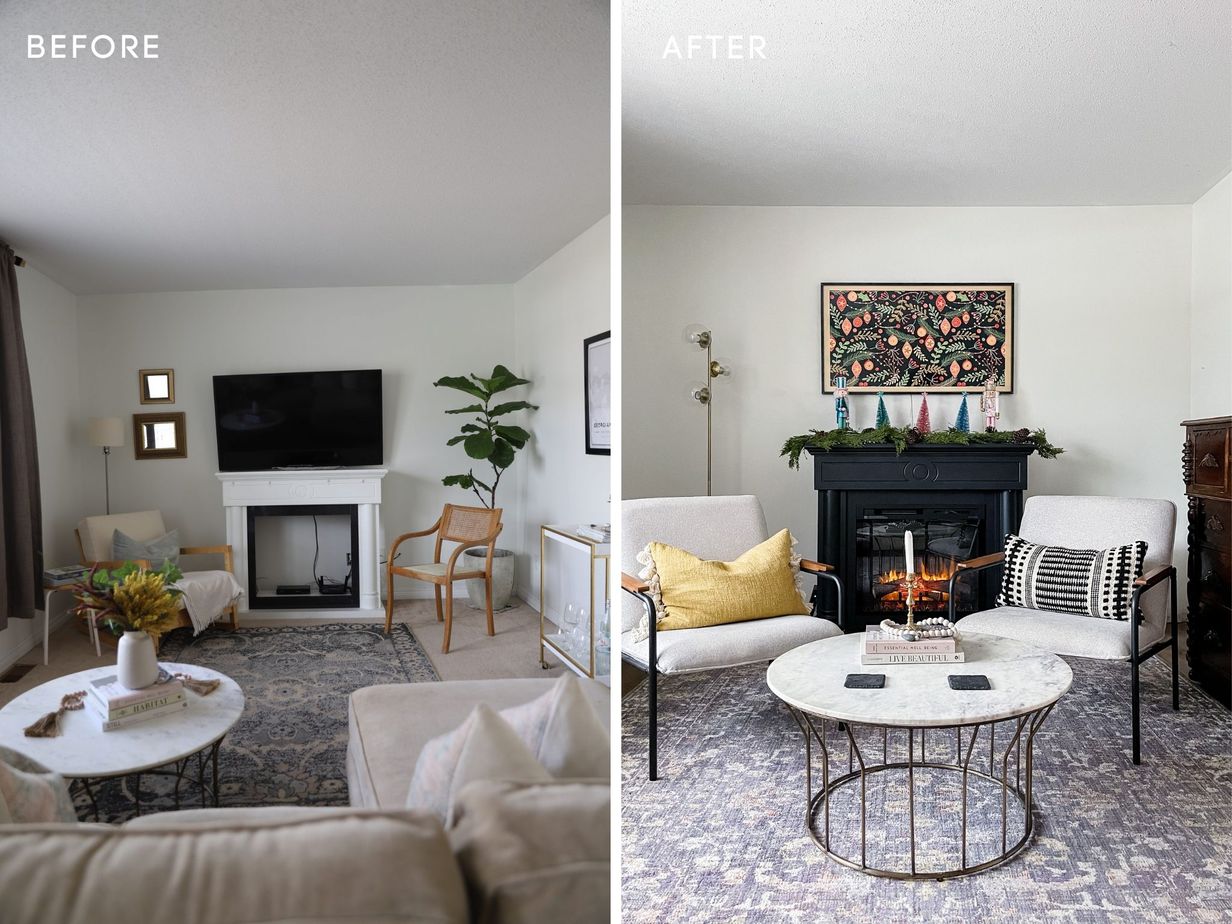Homeowners commonly prioritize their living room when planning to renovate their houses. It’s not a surprise, especially since families spend most of their time bonding in the house’s living space. Additionally, it’s a critical area in the home for comfort and an excellent first impression. A welcoming and cosy living room can create a positive impression on guests and anyone there. That’s why homeowners must put much effort into ensuring their living space is visually appealing. A living room makeover can come in various forms, from a brief update to a complete overhaul. Whether you are refreshing the paint or revamping an entire house, there are several things to consider that will maximize the benefits of your living room renovation.
Firstly, contemplate how you intend to utilize the space. Are you in need of more seating to accommodate guests? Should the room be more practical for everyday activities? Once you have a clear idea of how to use the area, you can begin crafting a detailed plan.
However, the renovation process can be exciting but also overwhelming. Determining where to start and how much to spend can be challenging. Additionally, selecting a reliable contractor who can deliver excellent artistry and help you check costs for your next project can take time and effort. Fortunately, here’s a simplified process for you. If you plan to renovate your living room, here is a step-by-step guide to help you get started.
Determine your focal point

Image Source: McCabe House
The aesthetics of your living space play a significant role in reflecting your artistic sensitivity and personality. It’s essential to consider a striking focal point in the design that will catch the attention of your visitors. You can achieve this by incorporating unique architectural designs, stunning windows from the window factory, original art pieces, feature walls, vintage mirrors, and gorgeous bookshelves. A focal point adds beauty, gives the room a purpose, and can be used as a conversation starter. It’s a chance to showcase your individuality and creativity, setting the tone for the rest of the room’s decor.
If your main goal in your living room is to use it as a space for entertainment, then you should plan on making the TV the room’s centrepiece. Pair it with a beautiful fireplace, feature wall, or bookshelf. It will create an exciting and engaging space for your guests to enjoy. However, it’s important to remember that whatever your focal point may be, arranging your furniture around it will bring out the best in it. Additionally, experts recommend setting up a lounge area around the focal point to encourage interactive chats, making people feel comfortable and at ease.
Determine the objective of your living room renovation

Image Source: Adobe
At the onset of any remodelling project, it’s crucial to determine its purpose. For instance, decide whether or not you’re renovating your space because you plan to sell it or because you want to breathe new life into it. If you plan to stay home after the remodel, you can choose finishes that match your style and preferences. In this scenario, you can select design elements that speak to you without concern for their potential impact on resale value.
Conversely, if you want to sell your home, opting for neutral finishes for permanent features like walls, ceilings, and floors is wise. This approach will allow prospective buyers to envision themselves in the space, regardless of their unique tastes. Additionally, introducing character through furniture and artwork can enhance the overall look and feel of the home. To create the illusion of more space, you can carry finishes and furniture styles from the house’s interior to the exterior, creating a cohesive aesthetic throughout the property.
Ultimately, whether you are renovating to sell or for your enjoyment, it’s crucial to approach the project with careful consideration and attention to detail. By selecting finishes and design elements that cater to your intended purpose, you can ensure that your living room renovation achieves its desired impact.
Research and plan

Image Source: J&L Building Materials
Thorough planning and extensive research are integral components of a successful home renovation. If you’re undertaking structural remodels or working with multiple professionals, the importance of your researched information can’t be overstated. It’s vital not to rush into the renovation process. Planning beforehand will help you avoid any potential regrets after completion. Remodelling is a step-by-step process requiring patience to ensure everything is done correctly. While having a clear idea of what you want to achieve is essential, it’s equally important to plan the steps you’ll take to get there.
In the planning stage, you’ll need to consider the scope of your project, your budget, and the timeframe for completion. Additionally, it’s essential to factor in any unforeseen costs or issues. Depending on the extent of the renovation, you may need to consult with professionals such as architects, contractors, and interior designers to ensure that your plans are feasible and practical. Moreover, thorough planning and research will help you avoid pitfalls and ensure that your living room renovation exceeds your expectations.
Consider your lifestyle for living room renovation

Image Source: Sugar and Cloth
When considering a living room renovation, it’s essential to imagine the type of living space that you desire for yourself and your family. For example, will the living room be primarily used for large gatherings or more intimate get-togethers? It’s also important to consider whether you prefer one big lounge area or multiple seating rooms. Thus, your lifestyle will determine your living room’s design and renovation costs.
In addition to considering your current lifestyle, it’s wise to consider your long-term objectives when renovating your living room. For example, suppose you’re a newlywed couple planning to start a family in a few years. In that case, it’s essential to consider how the space will accommodate children so you won’t have to remodel everything later. Similarly, if you live with older people, designing a comfortable and safe area for them is crucial.
Figure out your flooring options

Image Source: A beautiful mess
Flooring is an integral part of interior design when renovating your living room. It’s what ties together all the other decorative elements in the space. Therefore, it’s essential to consider the available flooring options carefully. Since floors are susceptible to regular wear and tear, choosing a durable and functional material that can withstand heavy traffic is vital. It means that homeowners should consider practicality when selecting between floor carpets and tiles.
Hardwood floors, for instance, are appealing and can tolerate massive foot traffic. Vinyl flooring, on the other hand, is attractive and affordable. Vinyl tiles, meanwhile, can be installed quickly and mess-free on top of your current cement or tile floor. When choosing the flooring colour and pattern, you should consider how it will integrate other interior décor elements.
Rugs can be a simple and effective solution if your budget is tight. Sisal or other fibre rugs provide an impartial basis for your home, which can be easily changed in a few years without remodelling the entire flooring. Concrete flooring is also an option that provides a modern and easy-to-clean look. Concrete stains create a warm and natural look, while polishing gives a modern and sleek look. A good sealer can protect the floor from spills, making it a low-maintenance option.
Determine your colour palette

Image Source: Forbes
The colour scheme in the living room is crucial for renovation as it is often the house’s most visible and frequented area. Its design and colour scheme can significantly impact the mood and atmosphere of the space, affecting how comfortable and inviting it feels. While other rooms may not require as much attention to colour, the living room is a space for relaxation and socializing, and therefore its colour scheme should be carefully considered.
Selecting the right colours for walls, furniture, and accents can create a cohesive, harmonious look that complements the interior design. On the other hand, choosing the wrong colours can create a chaotic and uninviting atmosphere that can detract from the overall experience of the space. Interior designers recommend neutral colours such as ivory, beige, taupe, grey, and black. These colours provide a blank canvas to add bold elements and emphasize textures and furnishings. Neutral colours work well with all designs, whether traditional or modern, and make your living space appear welcoming, cosy, warm, and clean.
Review your layout design

Image Source: Cottage Living and Style
Sometimes, the easiest way to give your living space a fresh feel is by simply changing the layout. Whether rearranging furniture or relocating to a new room, a different arrangement can provide a fresh look. While living rooms tend to have a central point like a fireplace or television, furniture can still be moved around to create a new layout.
In the past, living spaces were typically small and compact. However, with modern open floor designs, homeowners have more extensive living areas. If you have an adjoining room that isn’t being utilized, it’s possible to eliminate the dividing wall and enlarge your living room area. While the job isn’t complex, it can be chaotic, so it’s essential to ensure the wall isn’t load-bearing.
Create and stick to your budget for living room renovation

Image Source: V+ Studio
Creating and sticking to a budget is essential to any home renovation project, including the living space. Knowing how much you’re willing to spend before embarking on any remodelling or redesigning project is crucial. Your budget should include all the materials, labour costs, and any other expenses that may arise. Once you have a clear idea of your budget, it’s essential to stick to it to avoid overspending. However, this doesn’t mean you should compromise on the quality of materials or artistry. You can still get great results within your budget by shopping for the best deals and negotiating with contractors.
Conclusion
Designing and remodelling your living space can be an exciting and fulfilling task. By considering lifestyle, aesthetics, flooring, colour schemes, and layout factors, you can create a space that reflects your personality, meets your needs, and provides comfort and relaxation. Developing and sticking to a budget is essential to ensure you don’t overspend and regret your choices later. With careful planning and attention to detail, you can transform your living space into a welcoming and stylish environment that you and your family will enjoy for years.


























